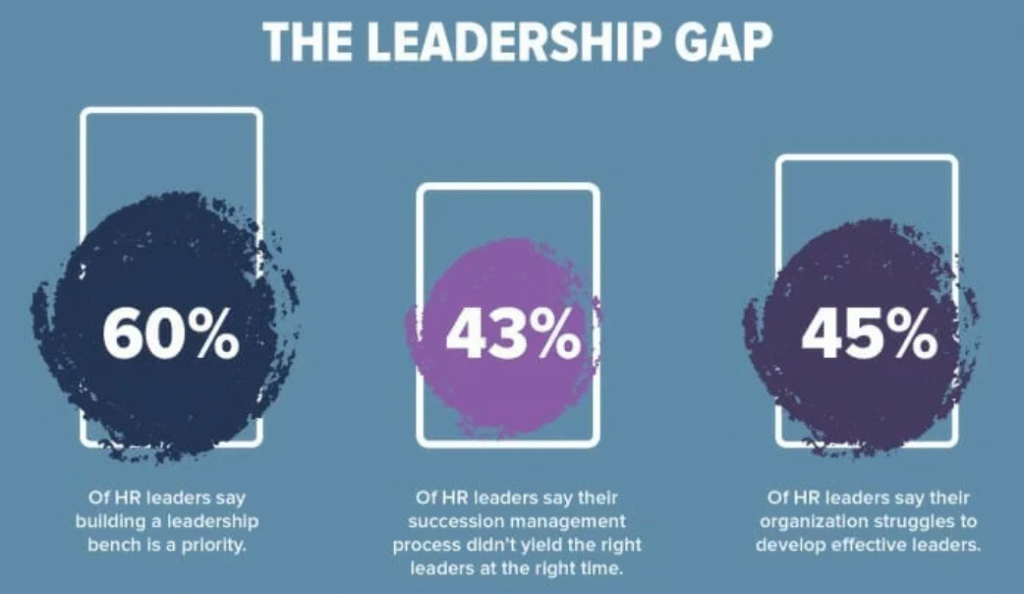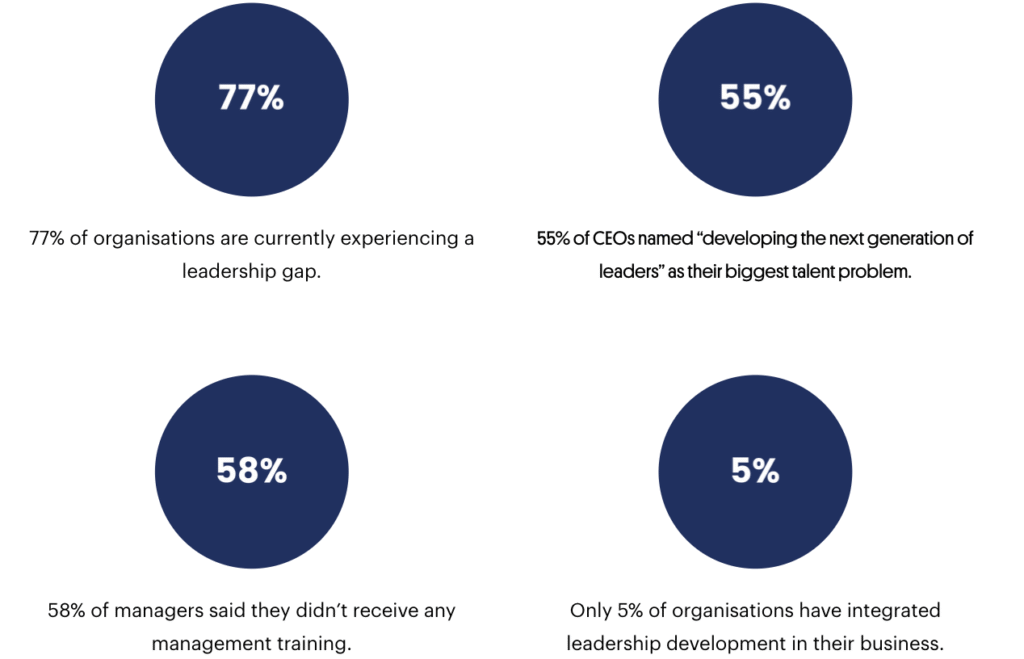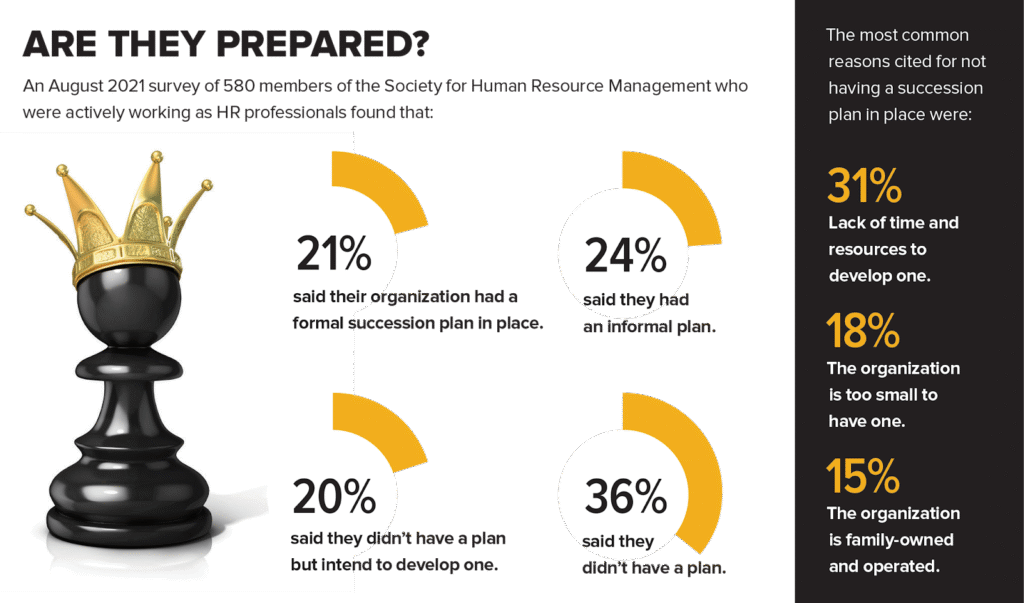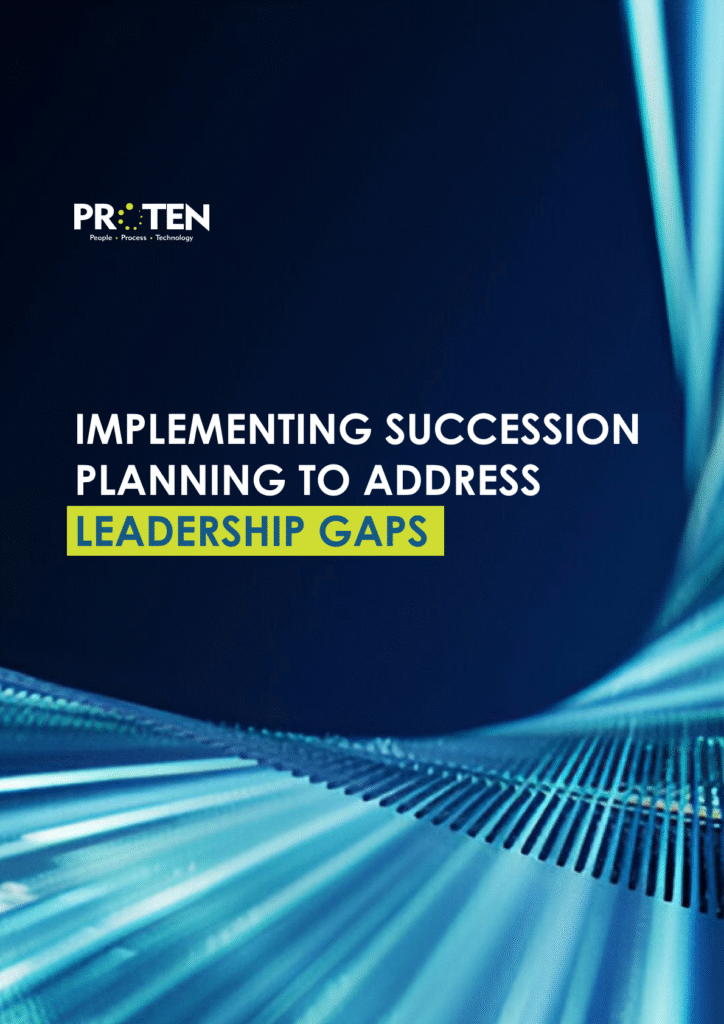Leadership is the backbone of any organisation, driving strategy, culture, and performance. Yet, many organisations are unprepared for leadership transitions. A 2023 survey by Deloitte found that while 86% of executives believe succession planning is a priority, only 14% feel their organisations do it effectively. A similar survey by McKinsey found that four in five global leaders believe they are unprepared for their new leadership roles. The result is a growing prevalence of leadership gaps—vacancies or underprepared leaders that disrupt operations and erode competitive advantage.

Source: SHRM
Many organisations face the challenge of ensuring continuity and resilience in leadership amidst rapid change, retirements, and unexpected departures. Leadership gaps—whether due to ageing workforces, turnover, or insufficient preparation—threaten operational stability, employee morale, and long-term success.
Succession planning, a proactive strategy to identify and develop future leaders, offers a robust solution to bridge these gaps. Next, we will examine leadership gaps and their impact on organisations, and provide a detailed framework for implementing effective succession planning. By aligning talent development with organisational goals, companies can mitigate risks, enhance adaptability, and secure a sustainable leadership pipeline.
Leadership Gaps in Modern Organisations

Source: HowNow
A leadership gap occurs when an organisation lacks qualified individuals to fill critical leadership roles, either due to vacancies or inadequate preparation. These gaps can manifest at executive, managerial, or specialised levels, affecting decision-making, team performance, and strategic execution. Some causes of leadership gaps are:
- Ageing Workforce and Retirements: In a survey by Inspire, 63% of millennials said their leadership skills were not being fully developed. Older employees are often critical repositories of knowledge and experience. However, when organisations fail to ensure the transition of this knowledge from the older generation to the younger generation, leadership gaps occur when these experienced leaders retire.
- High Turnover: When organisations fail to keep their effective leaders, leadership gaps occur. A 2024 Gallup report indicated that 52% of voluntarily exiting employees cited a lack of career advancement opportunities, often tied to poor leadership development. Unforeseen departures resulting from illness, resignations, or sudden terminations can also leave organisations scrambling to fill key roles.
- Failure to Develop Talent: According to a report by Gartner, five out of six HR managers are dissatisfied with the results of their leadership development programmes. Many organisations fail to invest in training and developing their leaders. This can be as a result of financial constraints, lack of management buy-in, or the wrong mindset or approach to leadership cultivation.
- Evolving Skill Requirements: As industries evolve and new technologies emerge, the competencies needed for effective leadership also shift. Leaders who once thrived may struggle to keep up if they fail to continuously enhance their knowledge and abilities. This is especially true in the era of digital transformation, where proficiency in emerging technologies and digital strategies is essential for success.
Consequences of Leadership Gaps
- Operational Disruption: Vacant roles delay decisions and stall projects. A 2022 McKinsey study found that companies with prolonged leadership vacancies experienced a 15% drop in productivity.
- Employee Disengagement: Leaderless teams report lower morale and higher turnover, costing organisations an estimated $1 trillion annually in voluntary exits (Gallup, 2023).
- Strategic Misalignment: Without capable leaders, organisations struggle to execute long-term visions, losing market share to competitors.
- Reputation Damage: Public failures tied to leadership instability can erode credibility and stakeholder trust.
Succession Planning as a Strategic Imperative

Source: SHRM
Succession planning is a systematic process to identify, develop, and prepare high-potential employees to assume critical leadership roles. Unlike replacement planning, which reacts to vacancies, succession planning is proactive, focusing on building a sustainable talent pipeline aligned with organisational goals. Succession planning is important for the success of an organisation for many reasons:
- Continuity: A succession plan reduces risk and disruption and ensures business continuity and seamless transitions in the case of an unexpected departure.
- Talent Retention: Succession planning provides high-potential, high-performing employees with a clear career path within your organization. This not only enhances engagement but also reduces the need for costly external hiring of senior employees and executives.
- Adaptability: Succession planning helps organisations build a pipeline of leadership talent capable of responding to changing business needs. This enables organisations to adapt effectively to volatile market conditions, customer needs, and emerging technologies.
- Cost Efficiency: Leadership recruitment can be a very costly affair. Internal promotions reduce recruitment and onboarding expenses by up to 50%, per a 2023 SHRM report.
Implementation Framework: Building an Effective Succession Plan
Step 1: Assess Organisational Needs
- Objective: Align succession planning with strategic goals.
- Actions:
- Conduct a workforce analysis to identify critical roles (e.g., C-suite, technical experts).
- Forecast future needs based on industry trends, retirements, and growth plans.
- Use tools like competency mapping to define required skills (e.g., strategic thinking, emotional intelligence).
Step 2: Identify High-Potential Talent
- Objective: Pinpoint employees with the capacity to grow into leadership roles.
- Actions:
- Leverage performance reviews, 360-degree feedback, and leadership assessments (e.g., Hogan or MBTI).
- Look beyond current performance to potential, using metrics like adaptability and learning agility.
- Ensure diversity and inclusion to build a representative pipeline.
Step 3: Develop Talent Through Targeted Programs
- Objective: Equip successors with the skills and experience needed for future roles.
- Actions:
- Offer stretch assignments (e.g., leading cross-functional projects) to test and build capabilities.
- Provide formal training, such as leadership workshops or MBA sponsorships.
- Pair high-potentials with mentors or executive coaches for personalised growth.
Step 4: Monitor and Evaluate Progress
- Objective: Ensure readiness and adjust the plan as needed.
- Actions:
- Track development milestones (e.g., completed certifications, successful projects).
- Conduct regular talent reviews with HR and senior leadership.
- Solicit feedback from successors to refine the process.
Step 5: Execute and Transition
- Objective: Seamlessly move successors into leadership roles.
- Actions:
- Create transition plans with clear timelines and knowledge transfer protocols.
- Communicate changes to stakeholders to maintain trust.
- Evaluate post-transition performance to refine future planning.
Measuring Success
To guarantee success, the effectiveness of succession plans must be tracked. According to a 2020 survey by the Institute of Corporate Productivity, about 70% of succession plans fail within two years. To evaluate the effectiveness of succession planning, organisations should track:
- Bench Strength: This refers to the percentage of critical roles with at least one ready successor (target: 75%+). Organisations must regularly assess the pipeline for potential successors for key positions.
- Time-to-Fill: Time to fill measures the length of time it takes to fill a critical leadership position once it becomes vacant. A shorter time to fill indicates that an organisation has a strong pool of internal candidates who are ready to step into leadership roles when needed.
- Retention Rates: Retention rates are another key indicator of effective succession planning. High retention suggests a strong talent pipeline, where employees feel valued and supported in their roles. Conversely, low retention may signal a lack of development opportunities or unclear career advancement paths within the organisation.
- Performance Metrics: To measure the effectiveness of succession planning, organisations can track the performance of the employees who take on new leadership roles, as well as the overall performance and productivity of the team after the transition period (e.g., team productivity, revenue growth).
Conclusion

Source: PWC
Leadership gaps pose a significant risk to organisational stability, productivity, and survival, but they are not inevitable. Through succession planning, companies can proactively cultivate a pipeline of capable leaders, ensuring resilience and competitiveness.
Effective succession planning ensures critical leadership roles are consistently filled, keeping your business running smoothly. A strong plan also nurtures top talent by providing clear career paths, enhancing employee engagement and retention. By investing in succession planning today, organisations can secure their tomorrow—bridging gaps, retaining talent, and driving sustainable success.
If you don’t have a succession plan for the key positions in your organisation, Proten International help with that. Now is the time to take proactive action, contact us today.

